Have you ever had a day where students don’t show up and you need a quick lesson plan, one section of a class is ahead of another, there’s a pep rally or vacation coming up, or you just need to survive the day with something different?
Well that’s where TPRS® Story Starters can come in handy!
If you aren’t familiar with them, TPRS® Story Starters contain various colored 4-paneled comics. In Volume 1, there are 62 comics included (with 21 additional single images) and in Volume 2, there are 82 comics included.
The following are 5 reasons why TPRS® Story Starters are a must have in any language classroom!
1. TPRS® Story Starters can be used by anyone!
- These images contain zero language. That means they can be used by any teacher of any class at any level! You get to be the one to decide the input your students get from them.
- Have a curriculum you have to teach? Find the comic or comics that fit your language targets for that unit and use them to deliver the input needed or for enrichment!
- Also if you’re collaborating with other teachers across languages in your school/district, you can pick out the same comic on the same day to talk about or use in class!
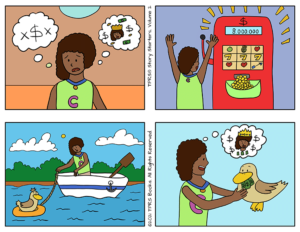
2. TPRS® Story Starters are a great way to deliver input to your classes!
- These images at times require the students or class to interpret what is going on! How could you deliver input, you ask?
- Create back-stories for the characters.
- Add more information about what happens in between the comic slides so they make more sense!
3. TPRS® Story Starters can be dramatized!
- TPRS® encourages using student actors to interview and ask questions as well as act out the story to further build interest!
- These don’t have to leave everything to the imagination because the story skeleton is already there!
- Embellish details via dialogue and improvisation!
- Come to one of our upcoming trainings if you want to learn how to dramatize in your classes with TPRS®
4. TPRS® Story Starters can be personalized!
- Anything in a TPRS® classroom can be a springboard for discussion once you have the skills!
- While talking about the comics, ask questions about people in your class to build interest, compare and contrast the characters, and give more opportunities for students to connect to the story as well as the language!
5. TPRS® Story Starters includes more than just comics!
- If those aren't enough reasons for you, all volumes of TPRS® Story Starters include 30+ listening, reading, writing and speaking activities to use in your classes to get more mileage out of them!*
Getting Started:
So how do we get started?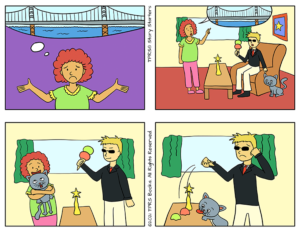 Well, the following might give you one idea of how you could use these in your classes!
Well, the following might give you one idea of how you could use these in your classes!
Day 1: Comic Talk 1
- Start asking questions about the comic to draw out students into being more engaged.
- Lead them through the story and allow them to fill in details.
- Consider adding parallel characters and dramatizing (TPRS® Skills).
Days 2-3: Comic Talk 2
- Continue asking questions about the comic and talking about parallel information with your students.
- Dramatize and interview your actors.
- Embellish as needed.
Days 4-5: Comic Talk 3
Option 1:
Continue developing your story and talking about it.
The beauty of TPRS® is that any “lesson” is simply used to trick students’ brains into paying attention to the R.I.C.H., flowing language.
Option 2:
Have your original story written out for the students to read.
You could do any of the reading activities or listening activities mentioned above.
Option 3:
If you didn’t finish any parts of the comic, consider having students write the ending.
Collect the endings, type up your favorites and have the class vote on which one is the “official ending”.
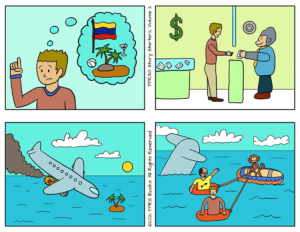 Or you could simply use these comics to start a story. Depending on the level of your students or your personal preference, you could show one of the four images, all of the images or any of the images. Then simply:
Or you could simply use these comics to start a story. Depending on the level of your students or your personal preference, you could show one of the four images, all of the images or any of the images. Then simply:
- ask varied questions to come up with a story with your class, or
- have students start telling a story.
And here are a few additional activity ideas (included in the full resource)!
1. Listening: Order the frames (page 14)
- Print off multiple copies of the same comic and cut up.
- Distribute cut up comic to each student. Read part of the story that goes along with the reading or come up with your own story with the language from your classes.
- Then tell the students to put the frames in order.
- Variations: Tell the story to your students before they see the comic.
- Tell the story once the students see the comic to put in order.
2. Reading: Matching (page 19)
- Teacher writes at least one sentence for each box and cuts into strips.
- Distribute comics and the sentences on the strips to students or groups.
- Have students place the cut-up strips into the frame they are describing until there are no sentences left.
- Check them to see how they did.
- They could also glue them on the paper if you’d like this for an assessment.
3. Writing: Write write write (page 21)
- Project a picture from a comic and have students in groups write as many possible sentences about it in a time period.
- Once the time is up, make sure pencils are down and have students use a different writing utensil to keep score.
- One group starts by having someone from that group go over all their sentences. For every sentence that could be used to describe the comic, their group receives a point.
- If someone has the same sentence or a sentence that is pretty close, they cross theirs out and it cannot be used for a point.
- Once that student gets something wrong or runs out of sentences, the next group may continue with someone naming off their sentences.
- This continues until nothing more can be said about the picture.
- Make sure that the same student isn’t always the representative for their group.
4. Speaking G: Two Truths and a Lie (page 26)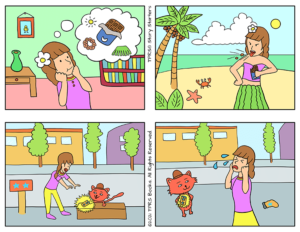
- Distribute comics to partners/groups.
- Have one of the partners pick a picture and say two truths and the lie.
- Their partner/group has to determine which are the truths and which is the lie.
- Then have their partner or someone else in the group go.
And that’s not all! Try the free samples available in our free resources section! (May require a free account)
*The additional ideas for Volume 1 and Volume 2 are the same.
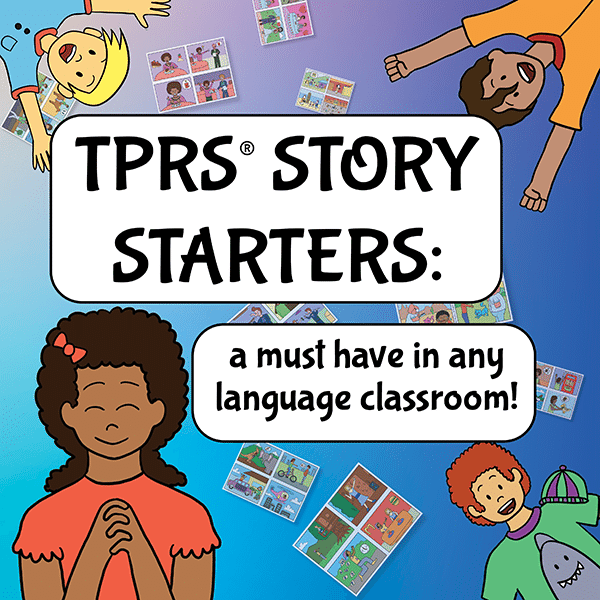

 Well, the following might give you one idea of how you could use these in your classes!
Well, the following might give you one idea of how you could use these in your classes! Or you could simply use these comics to start a story. Depending on the level of your students or your personal preference, you could show one of the four images, all of the images or any of the images. Then simply:
Or you could simply use these comics to start a story. Depending on the level of your students or your personal preference, you could show one of the four images, all of the images or any of the images. Then simply: